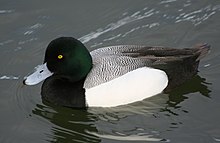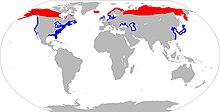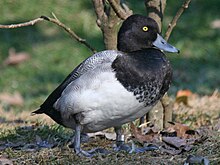Greater scaup: Difference between revisions
→Threats: rm "the" |
→Conservation: 11 per cent -> 11%, fo consistency |
||
| Line 55: | Line 55: | ||
==Conservation== |
==Conservation== |
||
[[File:Greater Scaup (Aythya marila) RWD1.jpg|thumb|left|Drake with a leg band|alt=Photograph]] |
[[File:Greater Scaup (Aythya marila) RWD1.jpg|thumb|left|Drake with a leg band|alt=Photograph]] |
||
During aerial population surveys Greater and Lesser Scaup are counted together, because they look almost identical from the air. It was estimated that the Greater Scaup made up about 11 |
During aerial population surveys Greater and Lesser Scaup are counted together, because they look almost identical from the air. It was estimated that the Greater Scaup made up about 11% of the continental Scaup population. Since the 1980s, scaup populations have been steadily decreasing. Some of the primary factors contributing to this decline are habitat loss, contaminants, changes in breeding habitat, and a lower female survival rate. The 2010 Scaup population survey was 4.2 million Scaup .<ref>{{cite web |title=Waterfowl Hunting Management in North America |work=Scaup Population Estimates |publisher=U.S. Fish and Wildlife Service in collaboration with flyway and state waterfowl managers |date=29 June 2010 |url=http://www.flyways.us/status-of-waterfowl/population-estimates/scaup-population-estimates |accessdate=4 November 2011}}.</ref> Along with the aerial population surveys, there is a banding program for the Greater Scaup. Metalic leg bands are placed on them, so that if the Scaup is killed by a hunter or if it is captured by another banding group, the number on the band can be reported to biologists and wildlife organizations. These banding programs yield valuable data about migration patterns, harvest rates, and survival rates.<ref name="FlywaysUS">{{cite web |url=http://www.flyways.us/surveys-and-monitoring/banding-and-marking-programs |title=Banding and Marking Programs|accessdate=28 November 2011}}</ref> |
||
A major threat to the Greater Scaup is habitat degradation in the [[Atlantic Flyway]]. Since 80 per cent of the Greater Scaup population winters in the urbanized part of the Atlantic Flyway, these ducks are subject to higher levels of organic contaminates, along with increased levels of heavy metals in foods and habitat, and in some cases, the Greater Scaup themselves.<ref name=BirdsNorthAmerica/> |
A major threat to the Greater Scaup is habitat degradation in the [[Atlantic Flyway]]. Since 80 per cent of the Greater Scaup population winters in the urbanized part of the Atlantic Flyway, these ducks are subject to higher levels of organic contaminates, along with increased levels of heavy metals in foods and habitat, and in some cases, the Greater Scaup themselves.<ref name=BirdsNorthAmerica/> |
||
Revision as of 01:20, 1 December 2011
| Greater Scaup | |
|---|---|

| |
| Adult male | |

| |
| Adult female | |
| Scientific classification | |
| Kingdom: | |
| Phylum: | |
| Class: | |
| Order: | |
| Family: | |
| Subfamily: | |
| Genus: | |
| Species: | A. marila
|
| Binomial name | |
| Aythya marila (Linnaeus, 1761)
| |
| Subspecies | |
|
A. m. marila (Linnaeus, 1761)  | |
The Greater Scaup (Aythya marila), just Scaup in Europe, or colloquially known as "Bluebill", for its bright blue bill, is a small diving duck. It breeds on the ground by lakes and bogs on the tundra and at the northern limits of the boreal forest across Arctic and subarctic regions of northern North America, Europe and Asia. The Lesser Scaup is a close relative of the Greater Scaup.
The drake, or male Greater Scaup, is larger and has a more rounded head than the female, colored black with a dark green tint. Its belly and flanks are bright white, its neck, upper chest, and tail feathers glossy black, and its lower flanks grey. The drake also has a white speculum on its wings.[1] The Greater Scaup feeds by diving underwater for aquatic plants and mollusks. Its large size and webbed feet allow it to reach food up to 20 feet (6 m) under water. The hen Greater Scaup is mostly brown with white patches surrounding her bill; she has a duller shade of blue on her bill and grey feet and legs.[1]
Taxonomy
The scientific name for Greater Scaup, Aythya marila, comes from the Ancient Greek word for an unidentified seabird.[2] The Greater Scaup was first studied by Linnaeus in 1761.[3] The Greater Scaups in America are distinguishable from the same species in Europe and Asia by stronger vermiculation on the mantle and scapulars, and are considered a separate subspecies, A. m. nearctica. Based on size differences, a Pleistocene paleosubspecies, Aythya marila asphaltica, has also been described from fossils recovered at Binagady, Azerbaijan. The Greater Scaup's name may come from "scalp", a Scottish and Northern English word for a shellfish bed[4] or from the duck's display call: "scaup scaup".
Description
The adult Greater Scaup is 39–56 cm (15–22 in) long with a 71–84 cm (28–33 in) wingspan and a body mass of 726–1,360 g (1.601–2.998 lb). It has a blue bill and yellow eyes and is 20% heavier and 10% longer than the closely related Lesser Scaup.[5] The male has a dark head with a green sheen, a black breast, a light back, a black tail and a white bottom. The adult female has a white band at the base of the bill and a brown head and body. The drake, or male Greater Scaup is larger and has a more rounded head than the female. The drake's belly and flanks are a bright white. Its neck, upper chest, and tail feathers are a glossy black, while its lower flanks are grey. The drake also has a white speculum on its wings.[1]
Distribution and habitat
The Greater Scaup is one of the rare circumpolar ducks, which means that it's range circles one of Earth's poles. It spends the summer months in Alaska and Siberia. The Greater Scaup also spends the Summer across the northern part of Europe. They are also found in Asia and the Aleutian Islands. They are found in the Aleutians year round.[6] The summer habitat is marshy lowland tundra and islands in fresh water lakes. In the fall, the Greater Scaup populations start migrating south for the winter. They winter along both the Pacific and Atlantic coasts of America, the coasts of northwest Europe, the Caspian Sea, the Black Sea, the coast of Japan, Yellow Sea and East China Sea.[7] During the winter months, it lives in coastal bays, estuaries, and sometimes inland lakes,[8] such as the lakes of Central Europe and the Great Lakes.[7]
In Europe, the Greater Scaup spend the summers in Iceland, the northern coasts of Scandinavia, including much of the northern parts of the Baltic sea, the higher mountains of Scandinavia and the areas close to the Arctic Sea in Russia. These birds spend the winters in the British isles, western Norway, the southern tip of Sweden, the coast from Bretagne to Poland, including all of Denmark, the Alps, the eastern Adriatic sea, the northern and western Black sea and the southwestern Caspian sea.[9][10]
In North America, the Greater Scaup summers in all of Alaska and the Aleutian Islands, Newfoundland and Labrador, along with Ungava Bay, the Hudson Bay, Lake Winnipeg, Northern Yukon, Northern Manitoba, and Northern Saskatchewan. It winters in Nova Scotia New Brunswick, and the entire west coast of British Columbia. It will also winter along the entire west coast of America, including the Baja Peninsula. Greater Scaup winter along the shores of the Great Lakes and the Gulf of Mexico. They also winter along the entire east coast of America, from Maine to Florida.[7]
Behaviour
Breeding
Greater Scaup breed all the way from Iceland to northern Scandinavia, northern Russia, northern Siberia and the western North American Arctic. They breed in the tundra and the boreal forest; it is estimated that 75% of the North American population breed in Alaska. Greater Scaup typically nest on islands in large northern lakes. Greater Scaup begin breeding when they are two years old, although they may start nesting at age one. Drake Greater Scaup have a soft quick whistle to get the attention of hens during their courtship which takes place from late winter to early spring, on the way back to their northern breeding grounds. Hen Greater Scaup have a single pitch, raspy “arrr-arrr-arrr-arrr-arrr” sounding vocalization.[11] The courtship procedure is complex and results in the formation of monogamous pairs.[12] They nest in close proximity to each other in large colonies, usually near water, on an island or shoreline, or on a mat of floating vegetation. The nest consists of a shallow depression made by the hen and lined with her down.[5] Hens lay an average of six to nine olive-buff colored eggs.[13] After the eggs are laid, the drake Greater Scaup will abandon the hen.[12] When the baby Greater Scaup are born, they already have down and are able to follow their mother on her search for food.[12] Although the baby Greater Scaups can swim and find food on their own soon after birth, it takes them to 40–45 days to learn how to fly.[7] The hen Greater Scaups will often work to defend their young from predators.[12]
Feeding

The Greater Scaup mainly eats mollusks, aquatic plants, and aquatic insects,[11] which it obtains by diving underwater. During the summer months, the Greater Scaup will eat small aquatic crustaceans.[5] There is a report of four Greater Scaups swallowing leopard frogs (with body length about 5 cm (2 inches)), which they dredged out of a roadside freshwater pond.[14] In freshwater ecosystems, the Greater Scaup will eat seeds, leaves, stems, roots, along with sedges, pondweeds, muskgrass, and wild celery.[1] Owing to the Greater Scaup's webbed feet and weight, it can dive up to 20 feet (6 m) and stay submerged for up to a minute, allowing it to reach food sources that other diving ducks are unable to take advantage of.[15] The Greater Scaup form large rafts with other Greater Scaup, some of which can contain thousands of birds. When these rafts are in water that has a current they will face it, and as the ducks float backwards, some fly to the front of the raft to keep it in the same position. The ducks in the raft dive to obtain food, which they eat on the surface.[5]
Threats
Common predators of the Greater Scaup consist of owls, skunks, racoons, foxes, coyotes, and humans.[3] Although the Greater Scaup has several predators, the most significant threat to its survival is habitat degradation caused by a mix of human development and runoff.[16] A joint group of American and Canadian scientists researching Scaup migration across the Great Lakes found that 100% of hen Greater Scaup, and 77% of hen Lesser Scaup, had escalated levels of selenium in their bodies. Selenium, a naturally occurring trace element that is semi metallic, occurs in some soils and is necessary for Greater Scaup in small levels. However Selenium, in large enough levels, can cause reproductive harm and is highly toxic. On their migration across the Great Lakes, Greater Scaups are at risk of ingesting selenium by eating the invasive zebra mussels, which can render a hen sterile.[17]
Conservation

During aerial population surveys Greater and Lesser Scaup are counted together, because they look almost identical from the air. It was estimated that the Greater Scaup made up about 11% of the continental Scaup population. Since the 1980s, scaup populations have been steadily decreasing. Some of the primary factors contributing to this decline are habitat loss, contaminants, changes in breeding habitat, and a lower female survival rate. The 2010 Scaup population survey was 4.2 million Scaup .[18] Along with the aerial population surveys, there is a banding program for the Greater Scaup. Metalic leg bands are placed on them, so that if the Scaup is killed by a hunter or if it is captured by another banding group, the number on the band can be reported to biologists and wildlife organizations. These banding programs yield valuable data about migration patterns, harvest rates, and survival rates.[19]
A major threat to the Greater Scaup is habitat degradation in the Atlantic Flyway. Since 80 per cent of the Greater Scaup population winters in the urbanized part of the Atlantic Flyway, these ducks are subject to higher levels of organic contaminates, along with increased levels of heavy metals in foods and habitat, and in some cases, the Greater Scaup themselves.[8]
Human interactions
Greater Scaup are a popular game bird in North America and Europe.[20] They are hunted in Denmark, Germany, Greece, France the United Kingdom, and Ireland,[20] and in Iran for both sport and commercial reasons.[7] Greater Scaup are hunted with shotguns, because they must be shot on the fly. Hunting Greater Scaup is very challenging, as they can fly at up to 75 miles per hour, which makes shooting them in flight very difficult.[21] Greater Scaup are hunted from shorelines and in open water blinds or layout boats, low-profile kayak-like boats that hunters lie inside. Hunters frequently use decoys to attract the birds,[21] often arranged to simulate a raft of Greater Scaup and featuring an open area to attract the birds to land.[21]
References
- Notes
- ^ a b c d "Greater Scaup". Ducks Unlimited. Retrieved 1 November 2011.
{{cite web}}: Check date values in:|accessdate=(help) - ^ "Scientific bird names explained". UK.Rec.Birdwatching. Retrieved 8 November 2011.
{{cite web}}: Check date values in:|accessdate=(help) - ^ a b "Greater Scaup". United States Fauna. Retrieved 2 November2011.
{{cite web}}: Check date values in:|accessdate=(help) - ^ New Shorter Oxford English Dictionary
- ^ a b c d "Greater Scaup". Bird Web. Seattle Audubon Society. Retrieved 26 October 2011.
{{cite web}}: Check date values in:|accessdate=(help) - ^ "Greater Scaup Aythya marila". Bird Life International. Retrieved 2 November 2011.
{{cite web}}: Check date values in:|accessdate=(help) - ^ a b c d e "Redlist". IUCN Redlist of Threatened Species. Retrieved 8 November 2011.
{{cite web}}: Check date values in:|accessdate=(help) Cite error: The named reference "EuropeBirdguide" was defined multiple times with different content (see the help page). - ^ a b "Greater Scaup". The Birds of North America. Cornell Lab of Ornithology. Retrieved 2 January 2011.
{{cite web}}: Check date values in:|accessdate=(help) - ^ Ullman 1992, p. 102
- ^ Delin 2001, p. 50
- ^ a b Mayntz, Melissa. "Greater Scaup". About.com. Retrieved 20 August 2011.
{{cite web}}: Check date values in:|accessdate=(help) - ^ a b c d "Greater Scaup". Utah DNR. Retrieved 8 November 2011.
{{cite web}}: Check date values in:|accessdate=(help) - ^ "Greater Scaup". National Audubon Society, Inc. Retrieved 27 November 2011.
{{cite web}}: Check date values in:|accessdate=(help) - ^ Longley, William H. (1948). "Greater scaup eating frogs" (PDF). Retrieved 12 November 2011.
{{cite web}}: Check date values in:|accessdate=(help) - ^ "Greater Scaup". Audubon. National Audubon Society. Retrieved 26 October 2011.
{{cite web}}: Check date values in:|accessdate=(help) - ^ "Greater Scaup". National Biological Information Infrastructure. Retrieved 8 November 2011.
{{cite web}}: Check date values in:|accessdate=(help) - ^ "Bluebills". MN Department of Natural Resources. Retrieved 3 November 2011.
{{cite web}}: Check date values in:|accessdate=(help) - ^ "Waterfowl Hunting Management in North America". Scaup Population Estimates. U.S. Fish and Wildlife Service in collaboration with flyway and state waterfowl managers. 29 June 2010. Retrieved 4 November 2011.
{{cite web}}: Check date values in:|accessdate=and|date=(help). - ^ "Banding and Marking Programs". Retrieved 28 November 2011.
{{cite web}}: Check date values in:|accessdate=(help) - ^ a b "EUROPEAN UNION MANAGEMENT PLAN" (PDF). EU. European Union. Retrieved 2 November 2011.
{{cite web}}: Check date values in:|accessdate=(help) - ^ a b c "Greater Scaup". Discover the Outdoors. Retrieved 19 November 2011.
{{cite web}}: Check date values in:|accessdate=(help)
- Bibliography
- Delin, Håkan (2001). Färgfotoguiden över alla Europas fåglar. Bonniers. ISBN 91-34-51940-8.
{{cite book}}: Invalid|ref=harv(help) - Ullman (maps), Magnus (1992). Fåglar i Europa. Wahlström & Widstrand. ISBN 91-46-17633-0.
Further reading
- Splitting headaches? Recent taxonomic changes affecting the British and Western Palaearctic lists - Martin Collinson, British Birds vol 99 (June 2006), 306-323
- Madge and Burn, Wildfowl ISBN 0-7470-2201-1
External links
- Cornell Lab of Ornithology: Greater Scaup
- USGS Patuxent Bird Identification InfoCenter: Greater Scaup
- South Dakota Birds and Birding: Greater Scaup
- Greater and Lesser Scaups, Environment Canada


